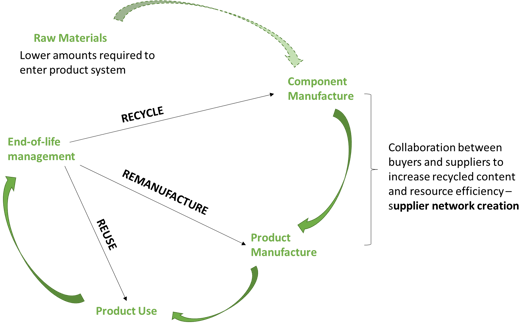Developing supplier networks: How supply chains are going circular
 Sophie Parsons, Senior Consultant at Greenstone, attended the resource efficiency event Resource held in London last week. In this blog, Sophie reflects on the role of supply chains in the circular economy.
Sophie Parsons, Senior Consultant at Greenstone, attended the resource efficiency event Resource held in London last week. In this blog, Sophie reflects on the role of supply chains in the circular economy.
Following the announcement of the EU Circular Economy Package at the end of last year, the transition to a stronger and more circular economy has become a hot topic. At Resource last week, organisations such as Rolls-Royce, Hewlett Packard and Jaguar Land Rover demonstrated how they aim to improve resource efficiency and gain greater circularity within their value chain.
Accenture estimates the circular economy to be worth $4.5 billion over the next 15 years [1]. With growing issues surrounding resource scarcity and increased waste, circular business models can help organisations reduce their environmental footprint and mitigate significant resource supply risk, as well as realise new revenue streams. A circular economy where resources loop back into the supply chain, and sharing or service-based models are implemented, could herald the end to current business-as-usual approaches to resource use.
What does a circular economy mean for supply chains?
Often the circular economy is defined as a greater focus on waste recycling, which is misleading. Supply chain decisions both upstream and downstream hold the key to a more circular and resource efficient business model, shifting away from the current status quo which is one of linear ‘take-make-dispose’.
Currently, the majority of organisations treat their suppliers as individual entities that are part of a linear system flowing in one direction. Little is understood about shared challenges or requirements within the value chain and there is little scope for collaborative thinking.

Current Linear Supply Chain Model
Within a circular economy however, supply chains can be defined as a network of interconnected goods and services flowing in two directions, where upstream and downstream organisations work together to recycle, reprocess and remanufacture goods to re-enter the product lifecycle. Here, much is known about each supplier within an interconnected symbiotic network.

Future Circular Supply Chain Model
Collaboration in the supply chain
In order to reach a circular supply chain model, organisations must begin to understand and engage with their supply chain. At Greenstone, we are seeing many organisations striving to improve their supplier engagement programmes and moving their supplier information management online.
Flexible solutions, like SupplierPortal, help companies transition to a circular supply chain by providing an online platform through which buyers and suppliers can share information securely. This should be the first step to creating a circular supply chain model, as buyers can manage data from their suppliers, identifying key challenges and opportunities within their supply chain. The ability for organisations, and more importantly sectors, to access this database of supplier information can act as an enabler for the type of supply chain collaboration required for circular thinking.
Greenstone enables you to engage your suppliers through its award-winning supply chain sustainability software and support services. SupplierPortal is a supply chain management software solution providing your business with transparency and compliance across your entire supplier network.










